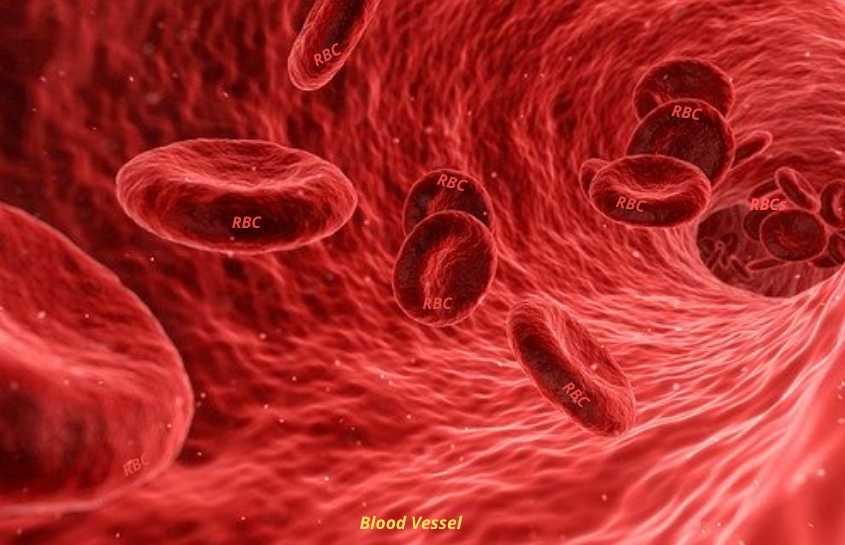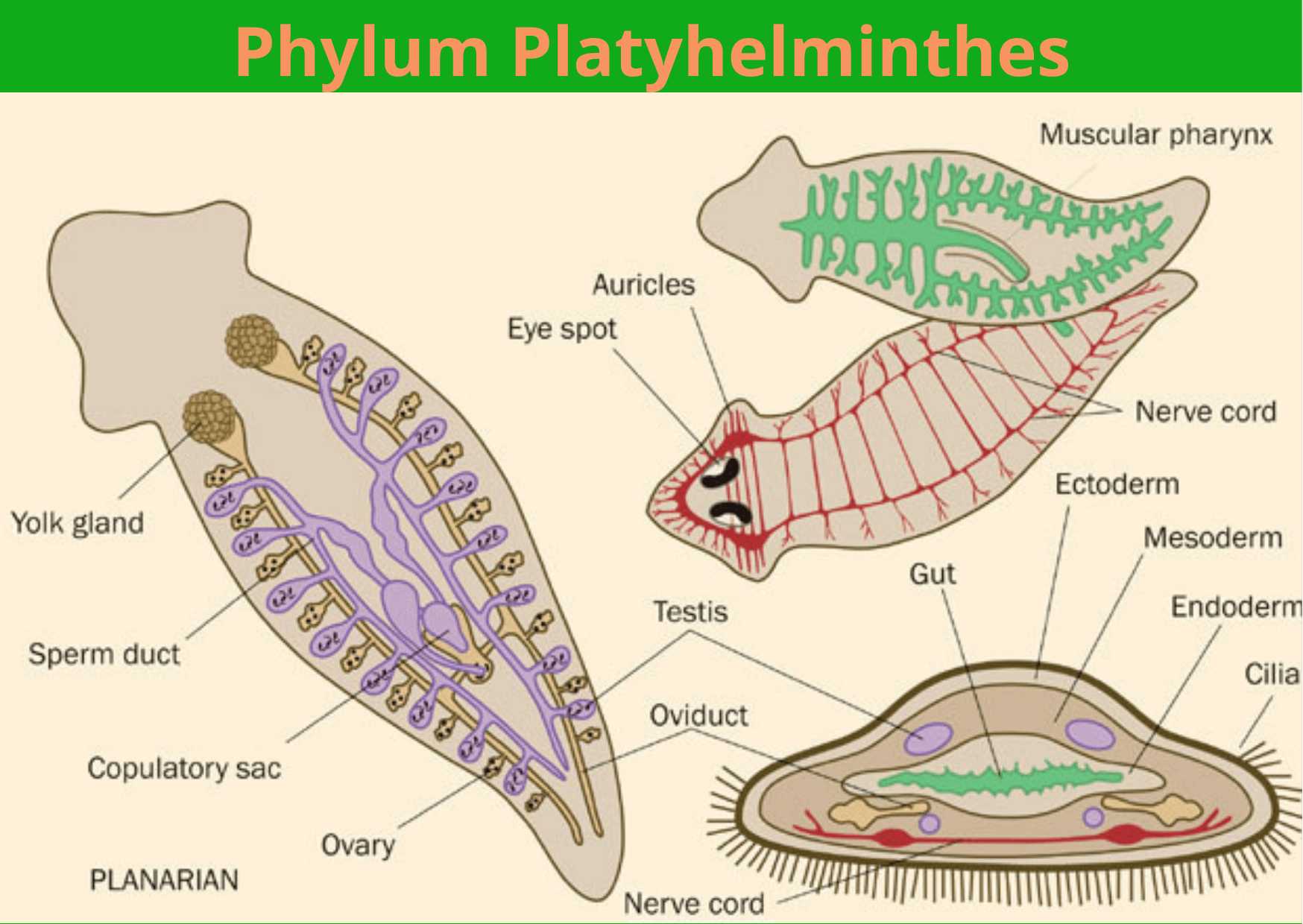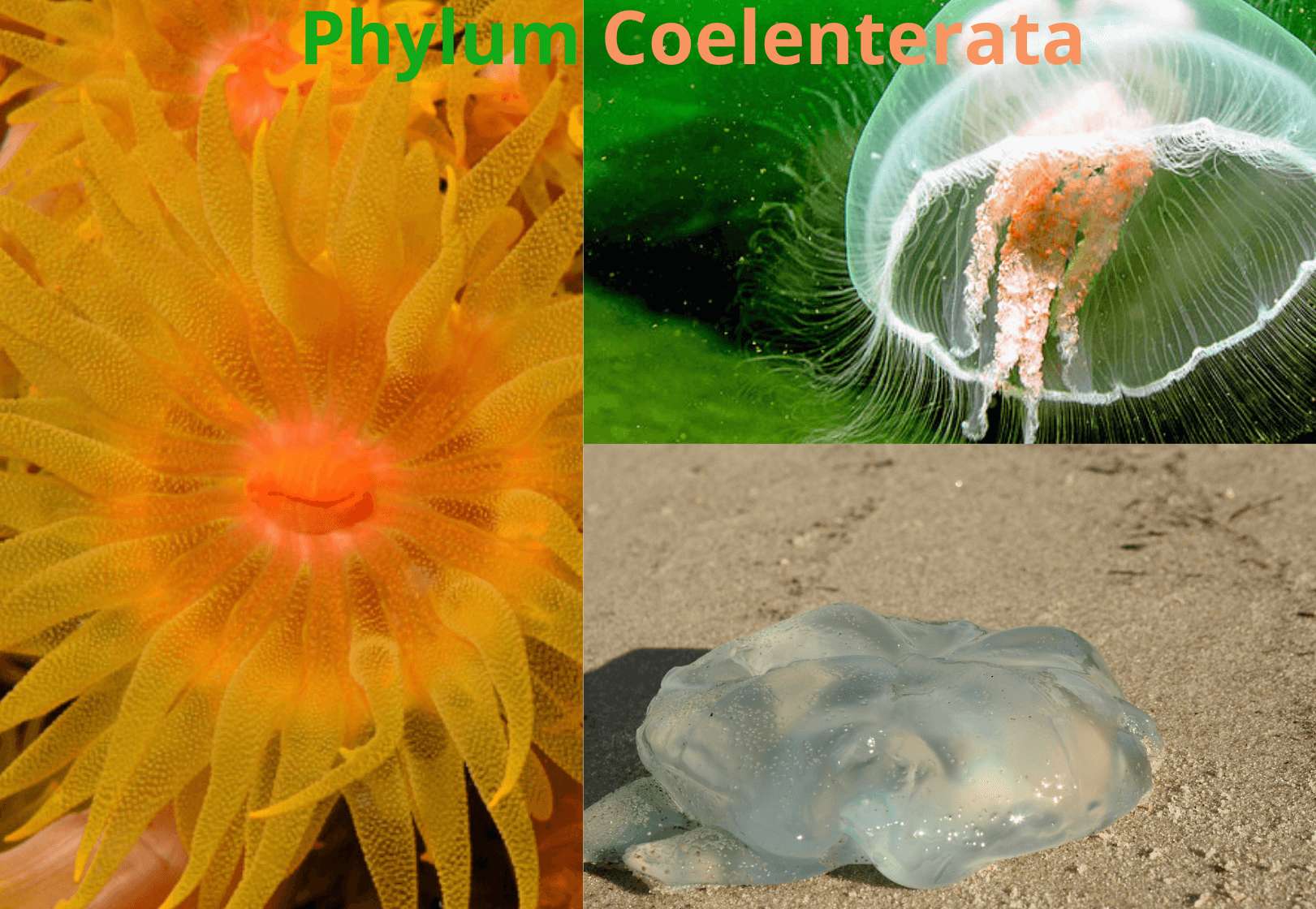Plasmodium is a digenetic malarial parasite. Digenetic means, organism that requires two host to complete their life cycle. Plasmodium is an endoparasite belonging to phylum protozoa. Female Anopheles mosquitoes are the vector of plasmodium which transfer the parasite to man. There are 4 species of plasmodium causing malarial fever in human.
1. Plasmodium Vivax: Cause benign tertian malaria. It is most dominant, cause about 80-85% of total malarial fever.
2. Plasmodium falciparum: Cause melignant tertian malaria. It is responsible for causing 10-15% of total malarial fever.
3. Plasmodium malariae: Cause benign quartan malaria. It is responsible for causing 2-3% of total malarial fever.
4. Plasmodium ovale: Cause sub-tertian malaria. Least or negligible responsible for causing malaria.
Plasmodium vivax is the major species responsible for causing malarial fever worldwide. It requires 2 host (organism) to complete their life cycle. Asexual cycle of plasmodium is completed in man and called as secondary host. Whereas sexual cycle is completed in mosquito and called as primary host. The site for asexual reproduction is human’s RBCs and liver cells. Sexual cycle takes place in gut and salivary gland of female Anopheles mosquito.
Asexual Cycle of Plasmodium Vivax
Asexual cycle is completed in 3-stages which occurs in RBCs and liver cells in human. When female Anopheles mosquito carrying plasmodium parasite bites a healthy man, the sporozoite are released into human blood. This marks the beginning of asexual reproduction in man. The 3-stages of asexual reproduction are:
- Pre-erythrocytic Cycle
- Exo-erythrocyic Cycle
- Erythrocytic Cycle
There are two important forms of plasmodium namely: sporozoite and trophozoite form/stage.
Sporozoite Stage of Plasmodium
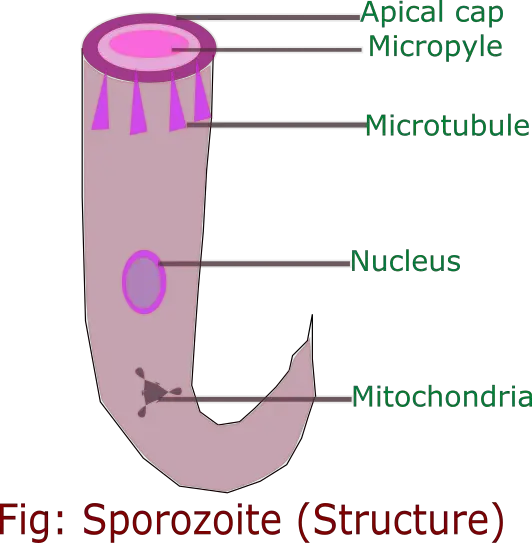
- Sporozoite are infective stage to human which are small, minute and sickle shaped.
- Body is covered with pellicle.
- Anterior end of body consists of concentric ring (apical cap)
- Tips of apical cap consists of small aperture called micropyle which acts as mouth.
- Apical cap secretes proteolytic substance which helps to dissolve the cell wall of liver cells.
- Its cytoplasm contains microtubules, large central nucleus and mitochondria. Microtubules helps in penetrating liver cells.
- Sporozoites is found in salivary gland of female Anopheles mosquito which is released to human blood during sucking blood by female mosquito.
Trophozoite Stage of Plasmodium
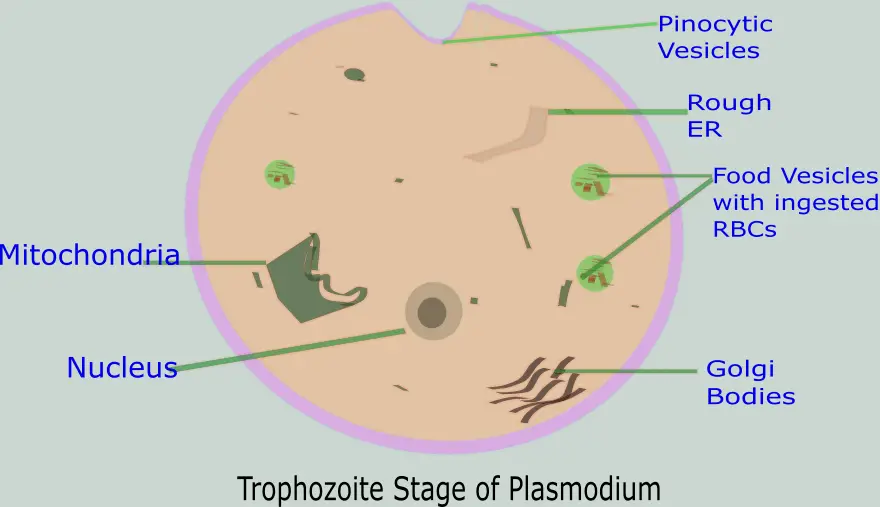
- Mature stage of plasmodium is called trophozoite.
- It is also called as mature, feeding and causative stage.
- It is found in human RBCs.
- It is a type of eukaryotic cell.
- Body is rough round shape with cytoplasm.
- Its cytoplasm contains a nucleus, mitochondria, food vacuoles with ingested RBCs, Golgi bodies and ribosomes.
- Body is covered with double layered cell membrane.
- Food is passed through pinocytic vesicles.
Pre-erythrocytic cycle
After an hour of bite by Female Anopheles, sporozoites released into blood reaches to live. Sporozoites then begins invading the liver cells. One sporozoites only invades one liver cell at a time.
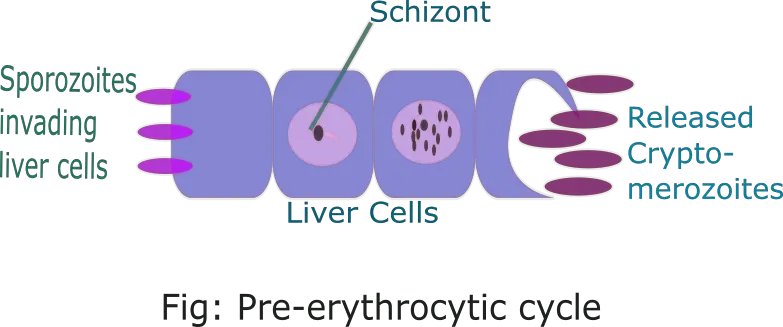
After penetrating liver cells, sporozoites changes to round shape which is called as schizont. Inside schizont, nucleus divides by multiple fission along with increase in size. It then finally comes out from liver cells by rupturing the liver’s cell wall. About 1,000-10,000 cryptomerozoites (cryptozoites) are released during this process.
Exo-erythrocytic cycle
Cryptomerozoites again invades fresh liver cells. Body becomes round shaped called schizont (as in pre-erythrocytic). In schizont, it divides and redivides by multiple fission and increases in size. Again, there is rupture of liver cells along with the release of about 100,000 metacryptomerozoites or metacryrtozoites.
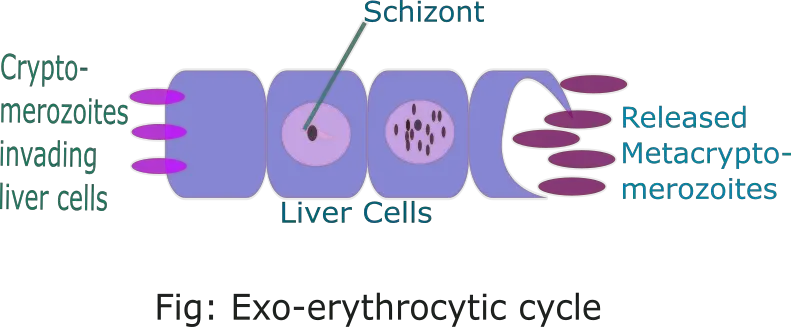
The released metacryptomerozoites are of 2-types namely: micro-metacryptomerozoites and macro-metacryptomerozoites. Micro-metacryptomerozoites are in small sized about 100,000 which attack RBCs. While macro-metacryptomerozoites are large in size about few in number about 64-100 only which again attack fresh liver cells and again repeat Exo-erythrocytic cycle.
Erythrocytic cycle
It occurs in RBCs of human hence called as erythrocytic cycle. Micro-metacryptomerozoites enters RBCs where it feeds on hemoglobin. It is called as trophozoite. It is completed in different stages.
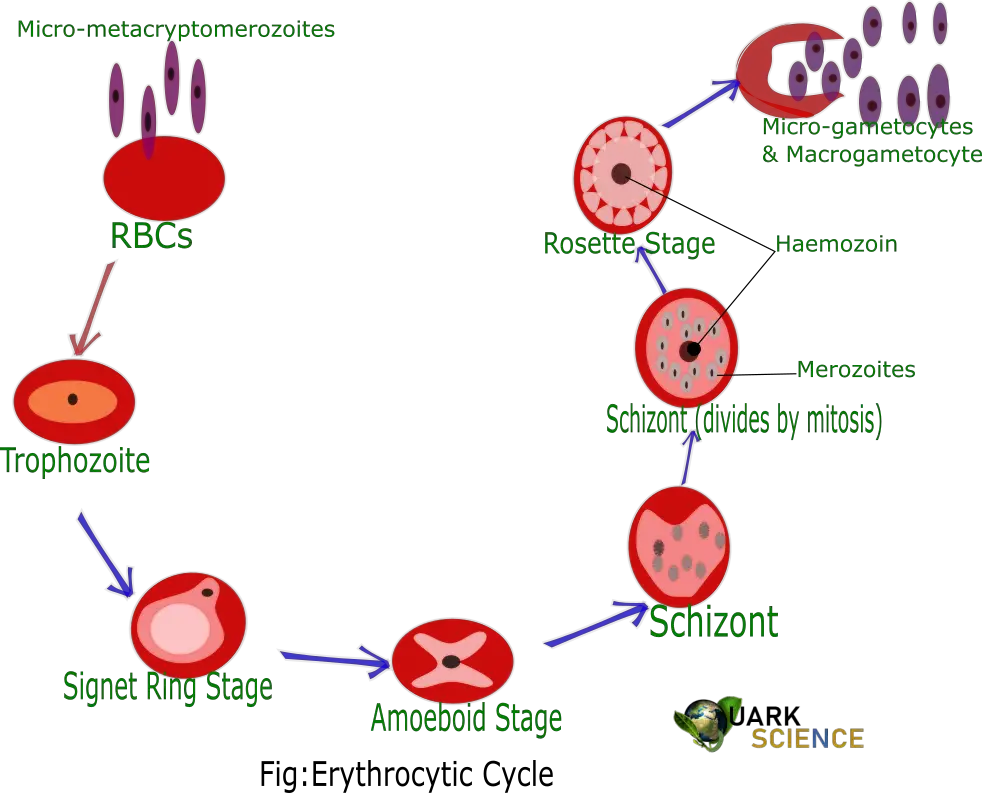
Signet ring stage: Trophozoite feed on haemoglobin and a vacuole is formed in the cytoplasm. As the vacuole grow, it pushes the nucleus to one side. This makes the appearance like signet ring.
Amoeboid stage: The vacuole soon disappears and give the shape like amoeboid called as amoeboid stage. During this stages, trophozoite feed on hemoglobin. Hemoglobin is composed of protein-globin which is digestible and iron compound-hematin which is indigestible compound.
During feeding, trophozoite digest globin while the undigestible hematin is released into blood stream in the form of hemozoin. Hemozoin is toxic and upon released into blood stream, it brings periodic fever in a malarial patient. Schuffner’s granule or dots are present in cytoplasm of RBCs which is orange or yellow in color.
Erythrocytic schizogony: The trophozoite nucleus undergoes repeated mitosis division and forms erythrocytic schizont. It changes to uni-nucleated merozoites after segregation of cytoplasm.
After repeated erythrocytic cycle, merozoites invading fresh RBCs develops into gametocytes. Gametocytes takes part in sexual reproduction.
Sexual Reproduction of Plasmodium Vivax
The gametocyte requires low temperature for further development. Due to this, gametocytes require transfer from man to female anopheles. When female anopheles mosquito suck blood from infected man, gametocytes are transferred to them. Gametocytes travel into stomach where they somehow escape digestion and hatch out from RBCs in the lumen of mosquito. It then actively involved in sexual reproduction.
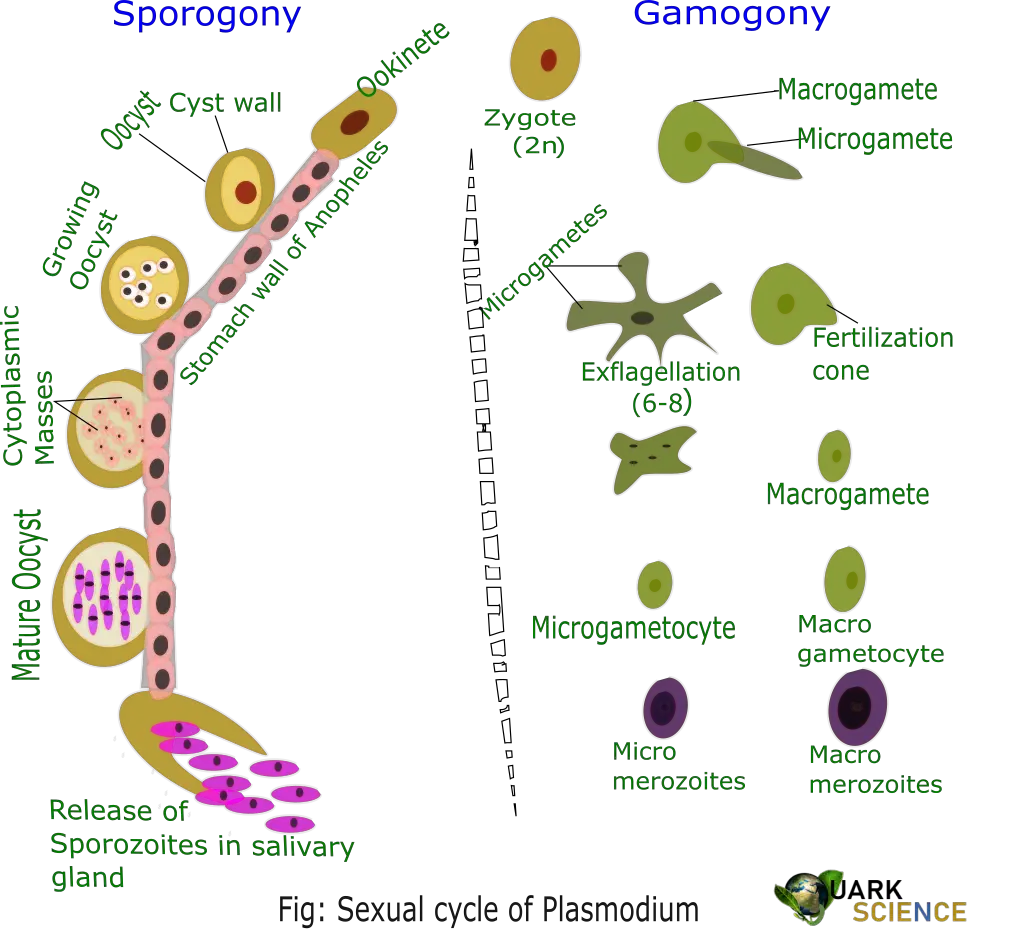
Sexual cycle of plasmodium is also divided into 3-stages namely.
- Gametogony
- Fertilization
- Sporogony
Gametogony (Gametogenesis)
The release of gametocytes from lumen of mosquito’s stomach and formation of sex cells are called as gametogony or gametogenesis. Two types of gametocytes are released, micro-gametocytes and macro-gametocytes. Micro gametocytes give raise to 6-8 haploid microgametes or male gamete. Micro-gametocytes give rise to 1 haploid macrogamete or female gamete.
Fertilization
Female gamete develops a projection for receiving male gamete which is called as cone of receptor or fertilization cone. The male gamete (micro-gamete) also develops a whip like structure which is called as exflagellation.
The macro gamete attracts the male gamete and attach it to the cone of fertilization. A zygote is formed after the fusion of both male and female gametes. A zygote develops into long, vermiform motile known as ookinete which has tapering end.
The ookinete penetrates the gut wall (peritrophic membrane) of mosquito with the help of tapering end and forms oocysts. Oocysts has cystic layer which is secreted by wall of mosquito stomach and partially by ookinete.
Sporogony
The oocyst is diploid in nature. The nuclei of each oocyst undergoes multiple fission producing about 10,000 of minute daughter nuclei. The cytoplasm of daughter cells gets vacuolated and many irregular cytoplasmic masses with nuclei at center is formed. Around nucleus, some cytoplasm constricted to form sporoblasts.
The nuclei of sporoblast again multiply and cytoplasm gets constricted around them resulting in the formation of sickle shaped sporozoites.
Due to formation of sporozoites into oocyst, its wall get ruptured and sporozoites are released into haemocoel of mosquito which then move to salivary glands and resides there waiting for another host(man) for next generation.
Important Facts on Plasmodium Vivax
Malarial fever is caused by a Protozoa called plasmodium but not a mosquito. Mosquito are only the vector which carries this parasite.
Transmission of malarial disease by Anopheles mosquito was discovered by sir Ronald Ross.
Mature stage of plasmodium is trophozoite which is called is a feeding and causative agent of malaria.
Infective stage of plasmodium is sporozoite.
The carrier or vector of plasmodium is female Anopheles mosquito.
Life cycle of plasmodium is digenetic i.e. asexual cycle is completed in man while sexual cycle is completed in female Anopheles mosquito.
Shivering occurs when merozoites releases from RBCs with toxin.
Recurrence of high temperature in malaria at certain interval is due to completion of erythrocytic schizogony in erythrocytic cycle.
Interval between inoculation and initiation of erythrocytic cycle is called pre-patient period.
References
1. https://www.tulane.edu/~wiser/protozoology/notes/mal_lc.html
2. https://www.ncbi.nlm.nih.gov/books/NBK5951/figure/malaria_LifeCycle/
3. https://www.nature.com/articles/ncomms8690?origin=ppub
4. https://www.frontiersin.org/articles/10.3389/fmicb.2015.00391/full

